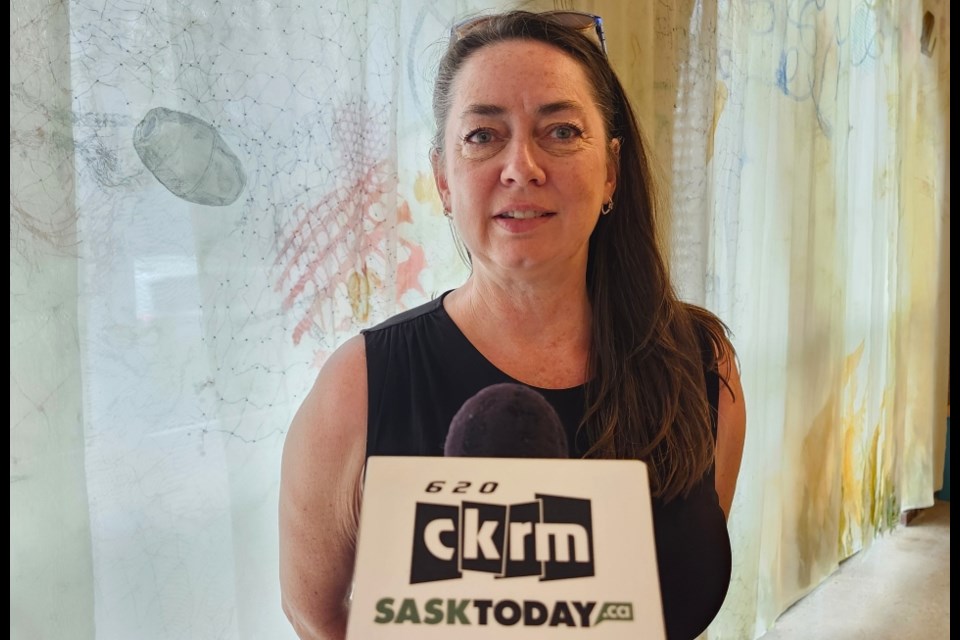SASKATOON — As Monique Martin’s art installation at the Nutrien Wonderhub nears the end of its exhibit, she is hopeful that people — especially kids — have learned the message of her work, An Ocean of Plastic, a wake-up call of how vital bodies of water are to our existence.
Martin has transformed the window side of Wonderhub’s Create Space into an immersive, underwater display composed of floating fabrics stencilled with images of various items that pollute our waters, including water bottles, buoys, ropes, flip-flops, toys such as shovels, Lego and Barbie dolls, and other plastic products.
Her latest visual art installation focuses on the ocean environment, showing visitors — particularly school children — the reality of how polluted oceans are. It captures the imagination with a combination of beauty and the man-made tragedy that has affected marine wildlife and habitats — a subtle message tucked behind each item.
"I wanted people to feel like they're underwater. When you push through the panels, it's like animals avoiding plastics. You're forced to interact,” Martin told SaskToday, noting that she designed her art installation for everyone to experience how sea creatures navigate waters cluttered with trash and debris.
Her installation consists of 100 panels, but only 45 were put up at the Wonderhub. The full version will be on display in Vancouver starting July 4, after the Wonderhub exhibit ends Friday, June 27. Martin and her studio assistant, Kelsey Ford, will hold an interactive workshop on the final day in Saskatoon.
In the Vancouver version of the exhibit, visitors will navigate through all 100 panels, which will be more tightly packed to enhance the feeling of swimming through ocean waters littered with trash. It will also include an auditory experience, with added sound effects mimicking plastic debris in water.
“We’re even adding ocean smells. The real buoys still hold the scent of the sea,” said Martin, noting the buoys were provided through a collaboration with Ocean Legacy and the Victoria Harbour Master, making every item not only environmentally themed but also environmentally sourced.
Martin added that she wants people to be educated after viewing the images of everyday and disposable items often thoughtlessly left behind on beaches. These items later end up in the ocean due to rising tides, yet have a significant environmental impact. She said she wants her work not only to be visually beautiful but also to convey a message.
“Most of my work isn’t made to match a couch. It’s made to match a cause,” she added with a smile, as she pointed to one of the images drawn on layers of second-hand fabric panels she dyed by hand. Plastic beads from her daughter’s wedding dress and gel medium donated from the studio of a late artist friend were among the other repurposed materials.
“Everything I make travels in three suitcases. If my work is about protecting the environment, I have to walk the talk,” said Martin, citing her commitment to minimizing the environmental impact of transporting her art.
Her process began in 2020, rooted in a moment of reflection after seeing plastic-filled canals in Amsterdam.
"That sat with me for years. All my art starts in the mind, and when I’ve felt enough, seen, and finally believe the idea is strong enough to build.”
She believes children are not just passive viewers but absorb everything they see and hear.
“Even if one of those kids goes home and remembers not to leave their beach toys behind, that’s a win for me.”
During Ocean Week, more than 2,300 people visited the Saskatoon installation. Many children participated in silk-screening pop bottles and creating art stamped with environmental messages.
Martin lectures and promotes awareness through her art, which can be both haunting and hopeful. Images of a Barbie doll scooter or beach shovel tangled in seaweed — or seemingly floating — are stencilled onto fabric panels.
“I want people to carry these images with them, to think before they drop that piece of plastic, because next time, it might end up in my art — or worse, in the stomach of a whale. We have plastics in our bodies; you may not notice it, but the fish we eat have it. Plastics break down into small pieces — microplastics,” Martin said.




